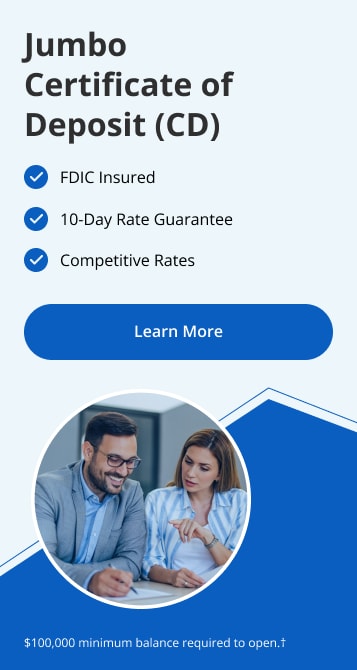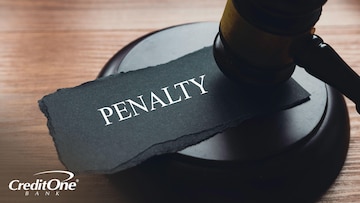How are CD Rates Determined?
July 31, 2023
Topics:
InvestmentsYou might know that a certificate of deposit (CD) can pay you a nice return. But did you know the various factors that determine those rates, and how to maximize your earnings?

Introduction
What do you do when you want to build your savings and maximize the interest rate you can earn … and you don’t need access to your money all the time? One option is to open a certificate of deposit (CD), which is like a cross between a long-term investment and a savings account.
CDs usually pay you a higher interest rate than most savings accounts. But in exchange for that return, you agree to leave your money untouched for a set period of time, or “term,” which could be anywhere from a few months to several years.
A CD reaches maturity at the end of that fixed term. Trying to take your money before it’s mature is like pulling a half-baked cake from the oven, and typically results in an early withdrawal penalty.
How CDs Work
Opening a CD is as easy as depositing your money with a financial institution and committing to the term. The general rule is that the longer you can leave your money, the more interest you’ll make.
CD interest rates are often described as an annual percentage yield (APY) because they earn compound interest. These rates are deliberately attractive because the bank is borrowing your money, kind of like a reverse loan. At the end of the term, you can withdraw the principal and the interest you’ve earned, or roll it over into a new CD.
Banks use the phrase “certificate of deposit,” but member-owned credit unions often call them “share certificates,” or just certificates. Depositors who keep their money in bank CDs are FDIC-insured, with the Federal Deposit Insurance Corporation (FDIC), and those who keep credit union certificates are backed by the National Credit Union Administration (NCUA). But no matter what they’re called, or whether they’re insured by the FDIC or NCUA, they function in essentially the same way.
What Factors Affect CD Rates?
Several factors determine CD rates, including the amount you deposit, the length of the CD term, the current national interest rates, and the financial institution itself.
- Deposit amount: Bigger deposits often earn higher interest rates because banks can earn more by investing larger sums of money. Many CDs even have a minimum required deposit amount.
- Term length: CD rates vary with the length of the term, and longer-term CDs generally offer higher interest rates. However, some institutions actually give a larger promotional rate on a shorter term.
- Institution policies: Each financial institution sets its own CD rates based on its business strategies, funding requirements, and competitive analysis. Outside factors still have some influence, but the final decision lies with the bank.
- Financial strength: Investors consider banks and credit unions with stronger financials to be safer than those with weaker reputations. So if a bank is doing well, and has better access to investor funds, it can usually offer higher CD rates in return.
- Market conditions: Overall interest rates in the market have a direct effect on CD rates, including the federal funds rate set by the Federal Reserve. Other economic conditions can also influence CD rates, such as inflation, gross domestic product (GDP) growth, and government monetary policies.
How To Get Higher CD Interest Rates
To maximize your CD interest rates, there are a few strategies you can take.
- Shop around: Your first step should be to compare the rates offered by different financial institutions. An online bank might have more competitive rates than a traditional brick-and-mortar institution, but financial reputation is also a factor.
- Go long: If you can commit to it, longer-term CDs usually offer higher rates than those with shorter terms.
- Go big: Many banks and credit unions offer higher interest rates on CDs with larger minimum balances. So the more you can deposit, the more you’ll typically make.
- Bump it up: “Bump-up” CDs allow you to increase your rate during the term, usually as a one-time option. So if you time the bump properly, you can take advantage of rising interest rates without having to cash out.
- Choose promotions: Some banks offer special promotions that can boost your CD interest rate by taking a specific term or meeting other conditions.
Risks and Considerations
CDs are a relatively safe form of investment since the return is guaranteed and the depositor is FDIC-insured. However, there are always considerations to keep in mind before tying up large sums of money.
- Limited liquidity: CDs aren’t as liquid as savings accounts, money market funds, or other types of investment and savings products. That’s because when you open a CD, you typically lock in the funds for the term’s full duration.
- Early withdrawal penalties: If you take out your money from a CD before the term is up, you will likely be charged an early withdrawal penalty. The amount varies, but it’s usually based on a portion of the interest — so you not only lose interest by closing the account, but you actually have to pay it to the bank as well.
- Opportunity cost: When you tie up funds in a CD, that money is out of commission for the term. So you could potentially miss out on getting higher returns from other investment opportunities that come along while your funds are maturing in the CD account.
- Inflation risk: Your CD rate might not keep up with inflation. This means the relative value of your money could decline over time as your purchasing power decreases.
Bottom Line
CD rates are determined by several things, including term length, financial institution policies, market conditions and economic factors. To get the highest rates possible, you should shop around, look for promotions, and consider larger or longer-term CDs.
Then compare the CD rates from different banks and credit unions. And finally, choose a financial institution that you trust. You can start that exploration by checking out the jumbo CD options with Credit One Bank. These financial products offer competitive rates that are among the highest in the industry.




